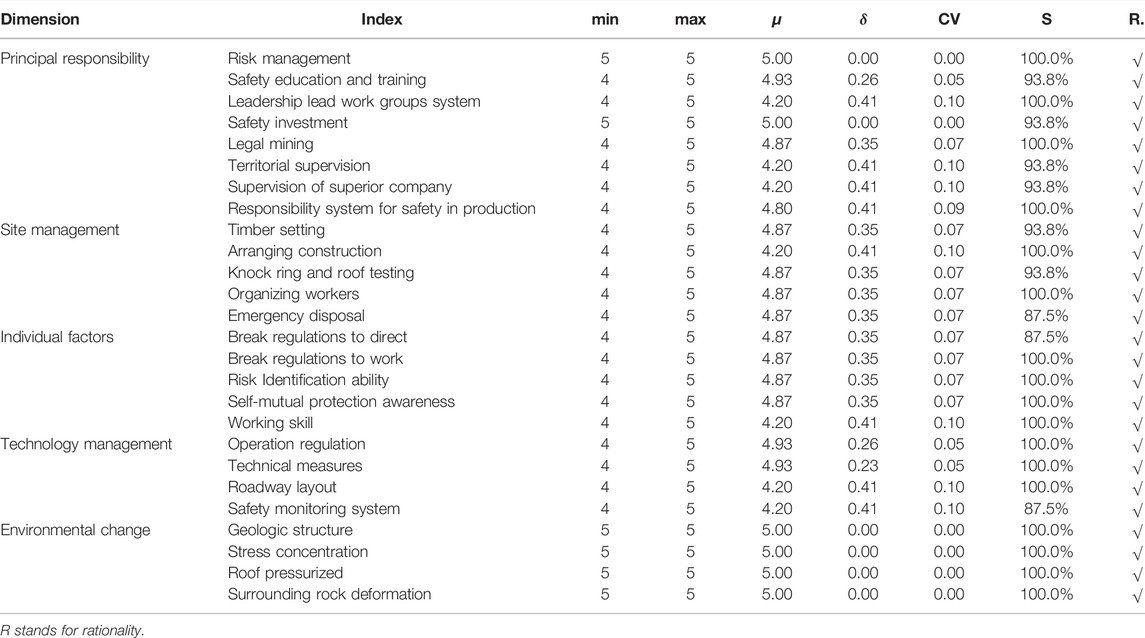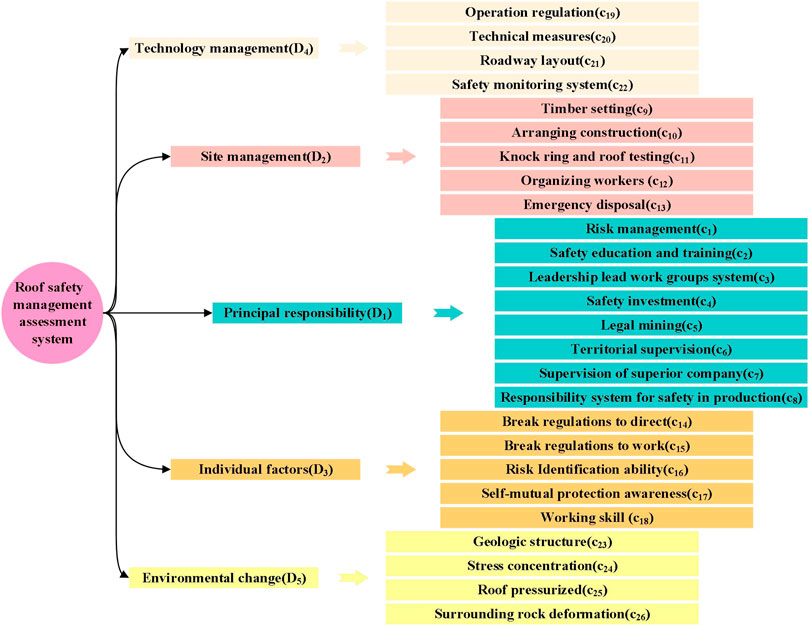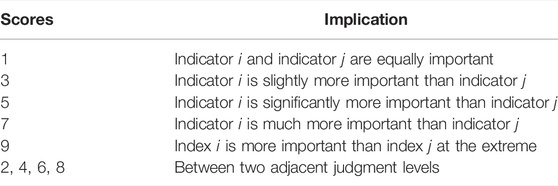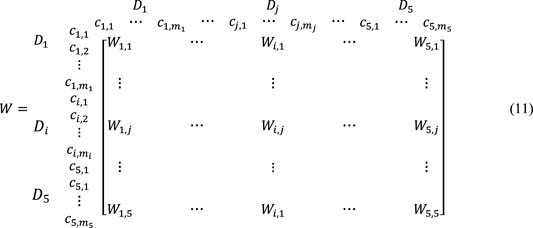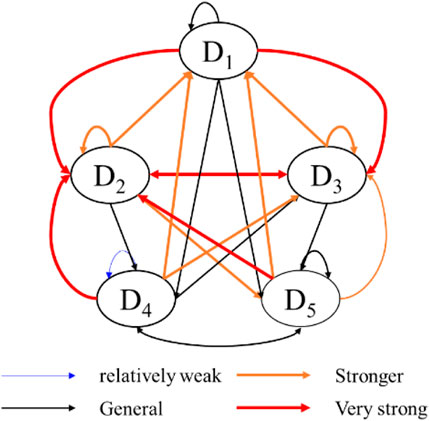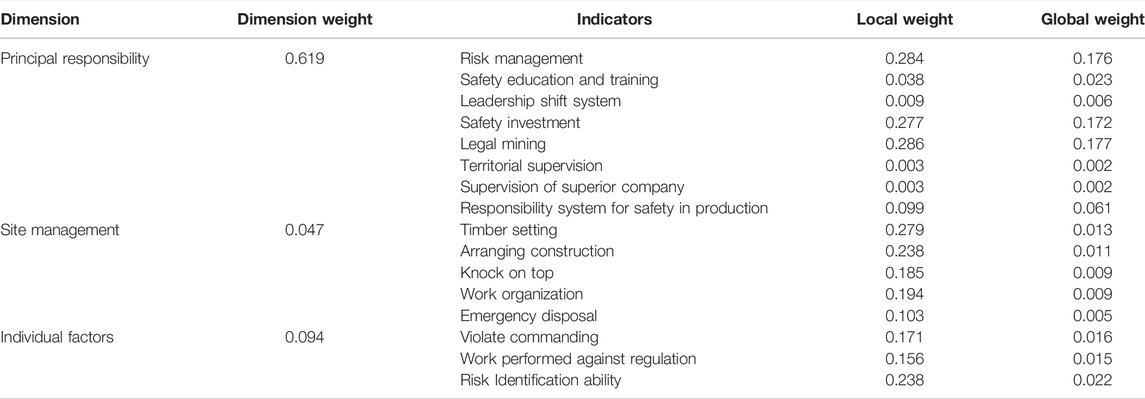- 1College of Safety Science and Engineering, Xi’an University of Science and Technology, Xi’an, China
- 2Key Laboratory of Western Mine Exploration and Hazard Prevention, Ministry of Education, Xi’an, China
Coal mine roof accidents are one of the main single risks faced by coal miners. According to the statistical data of coal mine accidents in China, there were 40 roof accidents and 55 deaths in 2020 alone, accounting for 32.8 and 24.4% of the total, respectively. Therefore, we can see its danger. To realize the comprehensive scientific assessment of coal mine roof accidents, first, through the collation and analysis of relevant literature reviews and accident investigation reports, combined with the expert investigation method, an assessment index system of coal mine roof accidents is constructed. Then, based on the analysis of the characteristics of the influencing factors of coal mine roof accidents, the assessment model of coal mine roof accidents is established by using the DEMATEL-ANP method. Finally, the established assessment model is applied to a coal mine to verify the rationality of the model.
1 Introduction
Roof accident is the type of coal mine accident with the largest number of occurrences and deaths. No matter what the scale of the coal mine is, there will be a certain degree of roof safety hazards in the mining process (Zhu et al., 2018; Xu et al., 2021; Zhang et al., 2021). However, because the occurrence of roof accidents is affected by many factors, it is difficult to prevent and control them, which seriously restricts the safe production of coal enterprises. Therefore, analyzing the causes of roof accidents and determining the influence degree of various factors to formulate effective prevention and control measures is still an important work content of the coal industry.
Roof fall refers to the sudden and violent collapse of the roadway roof, resulting in the collapse of roof rock. Roof fall is different from the rockburst disaster in deep engineering (Feng et al., 2015; Feng et al., 2022; Yu et al., 2022a; Yu et al., 2022b). However, it is also very dangerous and causes serious economic losses. Early studies were mostly considered from the perspective of geology and considered that weak and defective roofs, changes in stress conditions, and bedding plane faults and folds were the main reasons for roof collapse (Molinda, 2003; Phillipson, 2003; Düzgün, 2005). In recent years, with the deepening of research, the vibration, humidity in the air, coal pillar stability, and roof rock hanging length after the use of explosives have also been found to have an obvious correlation with roof falling (Yasidu et al., 2019; Liu et al., 2018). Because of the obvious differences in geological conditions in different regions, some scholars have carried out research on the causes of roof accidents under specific geological conditions. For example, Wang et al. (2018) analyzed a roof fall accident in the Huangyanhui coal mine in the Taihang Mountain area of Shanxi Province, China, and found that tectonic stress and fault sliding caused by mining activities are the driving forces of roof fall; Fei et al. (2020) found that under the condition of a thin bedrock and clay roof, the movement of post-mining overburden is complex. The analysis of the causes of roof falls has laid a certain foundation for evaluating roof safety and putting forward control methods, and relevant research has also been carried out. Oraee et al. (2016) believed that the discontinuity of geological structures would lead to large-area roof collapse, and proposed a roof fall risk assessment method based on structural data and analysis of wedge geometry and stability in coal mines. Bai et al. (2021) took the roof separation and horizontal displacement as the key factors leading to roof falling and proposed that the horizontal displacement can be reduced by increasing the bolt pretension load. Xiong et al. (2021) combined the analytic hierarchy process and fuzzy comprehensive evaluation method and established the cloud model of roof fall risk evaluation by constructing a quantitative grade interval and calculating the weight of each index.
To sum up, the research on the causes of roof falls, roof evaluation, and control is very rich, and the relevant achievements have also played an important role in reducing roof accidents and realizing the scientific management of roofs. However, after further analysis, it is found that the existing research is mainly carried out from geological or closely related factors, and the occurrence of coal mine roof accidents is the result of the coupling of geological uncertainty, stress change, mining conditions, surrounding environments, and safety management (Shen et al., 2017; Tubis et al., 2020; Njock et al., 2021). There is a certain one-sidedness in analyzing only from the geological aspect, and in terms of safety management, because of China’s unique coal enterprise management mode and national policies, a roof safety management evaluation method based on China’s national conditions is needed.
The Decision Making Trial and Assessment Laboratory (DEMATEL) is a method to solve complex and difficult problems in the real world by using the graph theory and matrix tools. The Analytic Network Process (ANP) method is a decision-making method based on the Analytic Hierarchy Process (AHP), which is suitable for non-independent hierarchical structures. The combination of DEMATEL and ANP can effectively reduce the inconsistency and uncertainty caused by people’s subjective judgment in the evaluation of roof safety management. Therefore, first, through literature sorting and the collection and analysis of roof accident investigation reports in China in the past 5 years, find out the influencing factors involved in the coal mine roof accident, classify the influencing factors through expert interviews, establish the coal mine roof safety management evaluation index system, and then use the DEMATEL-ANP to establish the coal mine roof safety management evaluation model for empirical applications.
2 Establishment of the Evaluation Index System of Coal Mine Roof Safety Management
2.1 Identification of the Influencing Factors of Coal Mine Roof Safety Management
Identifying the influencing factors of coal mine roof safety management is an important step in establishing the evaluation index system. To achieve this goal, the following databases were searched: Elsevier Science Direct, CNKI, Google academic, and SpringerLink. The combination of search terms used is roof accident or event and influencing factors, roof accident or event and evaluation, and DEMATEL-ANP. References cited in the article are also used as additional sources for our search.
In addition, to make the research conform to the actual situation of China’s coal mine production and national supervision, the coal mine roof accident reports published in China in the past 5 years (2016–2021) were sorted and analyzed to determine the factors not mentioned in the literature. There are 96 accident reports in total, and each report is proposed by the official investigation team formed in accordance with the requirements of laws and regulations and includes the analysis of the influencing factors leading to the accident. Since the accident investigation report comes from different accident investigation teams, there may be inconsistencies in the description of the same influencing factor. Therefore, integrate the different descriptions of the same influencing factor. For example, the safety education and training work are not solid, the safety education and training are not effective, and the safety education and training are not in-depth unified into safety education and training. To sum up, through the literature review and sorting of accident investigation reports, representative evaluation indexes of coal mine roof accidents are obtained, as shown in Table 1.
2.2 Selection of Evaluation Indexes for Coal Mine Roof Safety Management
For the identified 26 evaluation indicators, five experts were invited to interview and classify the indicators, including three scholars who have long studied coal mine safety management and two managers engaged in coal mine safety management. During the interview, the experts defined the meaning of each index in detail and classified the index on the basis of fully understanding the connotation and value of the index. Finally, according to expert opinions, 26 coal mine roof accident evaluation indexes were established and divided into five dimensions: principal responsibility, site management, technical management, individual factors, and environmental change, as shown in Appendix 1.
2.3 Establishment of the Evaluation Index System of Coal Mine Roof Safety Management
To further determine the effectiveness of the selected indicators and the accuracy of classification, the expert investigation method is used to analyze the rationality of the evaluation indicators. When using the expert survey method, the number of members of the expert group is generally not less than 10, but not more than 20, because when the number is more than 20, it has little impact on the accuracy of the evaluation results (Lin, 2017). Therefore, a total of 15 questionnaires were distributed and recovered, with a questionnaire recovery rate of 100%.
Using a Likert scale to measure and count the importance of preselected indicators, they is divided into five levels: 1 indicates very unimportant, 2 indicates unimportant, 3 indicates average, 4 indicates important, and 5 indicates very important. The maximum and minimum values of each index score are counted and recorded as
It can be seen from Table 5 that the coefficient of variation of all indicators is less than 0.2, and the s value is greater than 80%, that is, the classification of all indicators is reasonable and does not need to be modified. To verify the rationality of expert opinions, the Kendall W synergy coefficient is used for the consistency test, and its calculation formula is as follows:
where
It can be seen from Table 4 that the synergy coefficient of expert scoring is 0.621, indicating that the consensus of expert group members is strong, and the significance level
3 Construction of the Coal Mine Roof Safety Management Evaluation Model
3.1 Applicability Analysis of DEMATEL-ANP
The evaluation indexes of coal mine roof accidents affect each other, and the weight of each index is different. Enterprise managers need to not only know the evaluation results but also to clarify the influence relationship between various indicators and identify key factors, to take targeted measures for control and treatment. Using traditional evaluation and analysis methods, it is difficult to determine the complex relationship between indicators in a real situation, and the DEMATEL-ANP rule solves this defect well (Dehdasht et al., 2017). The DEMATEL has the advantages of not relying on big data samples and simplifying the factor correlation analysis. It can build a mapping structure with clear relationships between sub criteria for each criterion and establish a cause and effect diagram that can visualize the cause and effect relationship. In a network with relevant standards, the ANP can make the prediction more accurate through better priority calculation. At present, this method has been applied in many fields and received positive feedback (Chukwuma et al., 2021; Osintsev et al., 2021; Mubarik et al., 2021). Therefore, the application of the DEMATEL-ANP method for coal mine roof accident evaluation has the following applicability:
1) DEMATEL can clarify the relationship between evaluation indicators.
First, through the steps of determining the direct influence matrix, standardizing the direct influence matrix, and determining the comprehensive influence matrix, the influence diagram of coal mine roof accident evaluation indexes is drawn to intuitively show the interaction relationship between each index. Second, the ANP model of coal mine roof accidents is established by using the drawn influence relationship network diagram, to avoid the problem of being too subjective in determining the influence relationship of indicators. Finally, by calculating the influence intensity of the relationship between the indicators, the cause degree and centrality are determined. On this basis, the indicators are arranged according to the influence to identify the key factors affecting coal mine roof accidents and lay a foundation for formulating targeted control measures.
2) ANP determines the relative importance of the criterion layer and index layer of the index system.
After the DEMATEL identifies the relationship between coal mine roof accident indicators, the ANP can capture the interdependence between decision attributes to realize a more systematic analysis. First, compared with the AHP, which assumes that the relationship between indicators is independent, the ANP provides a more general decision-making model without assuming the independence between indicators at the same level and different levels. Second, by determining the index weight, enterprise managers can pay more balanced attention to the overall influence of various dimensions on roof accidents. Finally, when constructing the judgment matrix, the nine-level scaling method is used to assign the value, which greatly reduces the subjective influence caused by human reasons.
3.2 Evaluation Index Influence Relationship and Weight Establishment
3.2.1 Identifying the Impact Relationship Between Indicators
1) Determining the Direct Impact Matrix
To construct the network diagram of roof safety management evaluation, first, experts need to judge the influence relationship and degree of all indicators and form an influence relationship matrix. Among them, indicators
In actual decision-making, there will also be interactions between different dimensions and different indicators. It can be assumed that there is relationship between all indicators, but this assumption will lead to more complex problems. Therefore, this study assumes that the interaction relationship of 26 indicators is the same as that of five dimensions. The scoring results of each expert’s influence relationship are expressed in the matrix
The initial direct influence matrix
2) Normalized Direct Impact Matrix
The normalized influence matrix can be obtained by standardizing the direct influence matrix
3) Determining the Comprehensive Impact Matrix
The comprehensive influence matrix
where
4) Calculating the Center Degree and Cause Degree of Each Index
The sum of the values of each row and column of the comprehensive influence matrix
Based on the calculation of centrality and cause degree, using Equation (8), add the influence degree and affected degree of index
5) Drawing the Network Diagram
To more clearly describe the relationship between indicators, an impact relationship diagram with a threshold is established, which is used to deal with the impact value in the overall relationship comprehensive impact matrix
3.2.2 Determining the Index Weight
By determining the relationship between the criterion layers of the coal mine roof safety management evaluation index system, we can identify the criteria that have great influence or are easily affected. According to the DEMATEL analysis results, we can put forward scientific and reasonable improvement measures, but we should also clearly realize that the criteria closely related to other criteria are not necessarily the most important in the evaluation index system, and the weight of each index needs to be identified to determine the real key factors of roof safety management. Therefore, the ANP method is applied to further clarify the weight of each index.
1) Constructing the judgment matrix
According to the internal correlation of risk evaluation indexes in the DEMATEL model, the network hierarchy diagram of roof safety management evaluation is formed. For all indicators with a mutual influence relationship, the importance judgment is carried out by using the 1-9 scale method (Table 8), to construct the pairwise judgment matrix of the relative importance of indicators in a certain dimension with different indicators as the sub-criteria. Each group of judgment matrix is summarized to form the initial relative importance judgment matrix after checking the consistency through the consistency index
2) Getting the unweighted super matrix
Each group of pairwise comparison matrices is standardized and transposed to obtain the eigenvalue vector
3) Getting the weighted super matrix
Although each of the unweighted hypermatrices is normalized, the overall unweighted hypermatrix is not normalized. Therefore, by multiplying the standardized importance judgment matrix of each dimension with the unweighted super matrix, the standardization of the super matrix is realized, that is, the weighted super matrix is obtained.
Taking the safety evaluation of coal mine roof construction as the criterion and dimension
The matrix
4) Calculating local and global weights
To reflect the dependency between elements, it is necessary to stabilize the weighted hypermatrix, that is, calculate the limit matrix of the matrix. Calculate the multiple power of the weighted hypermatrix, and note that the
5) Determining the comprehensive weight
When the column vectors are equal, the hypermatrix converges to stability to obtain the limit relative ranking of the indicators in each dimension, that is, the weight of each indicator. The weight determined by the DEMATEL-ANP considers the relative importance determined by the influence relationship between indicators, so it can better adapt to the characteristics of mutual influence among coal mine roof safety management evaluation indicators.
4 Case Analysis
4.1 Data Collection
Based on the established risk evaluation index system and the DEMATEL-ANP risk evaluation model, 12 of the 15 experts were organized to conduct a five-day field investigation in the SL coal mine during the construction of the index system, meeting the requirements of 8–15 experts for the DEMATEL method (Mavi and Standing, 2018). Then, according to the present situation of roof management in the coal mine, a questionnaire survey was carried out among experts. The details of the members of the expert group are shown in Table 9.
4.2 Establishment and Analysis of Influence Relationships Among Indicators
According to the data collected by the questionnaire, first calculate the arithmetic average value from Equation 2 to form the initial direct influence matrix. Second, standardize the direct influence matrix according to Eqs (3), (4) to form a standardized direct influence matrix. Finally, calculate the comprehensive influence matrix
It can be seen from Table 10 that each dimension of coal mine roof safety management evaluation has an impact on the five dimensions (including itself) and is also affected by the five dimensions (including itself). But the degree of mutual influence is different.
Based on the comprehensive influence matrix
Finally, according to the results of Table 10 and Table 11, the network relationship model between each dimension is obtained, as shown in Figure 2. To show the strength of the influence relationship between different dimensions, Figure 2 is distinguished by the color and thickness of the line. The drawing of this model can lay a foundation for the drawing of the network structure in the ANP analysis.
4.3 Calculation and Analysis of the Evaluation Index Weight
Based on the final influence matrix and network relationship model determined by the DEMATEL, the ANP network structure diagram of coal mine roof safety management evaluation is constructed by using super decisions software, as shown in Figure 3. A loop indicates that there is an interactive relationship within each dimension.
After determining the structural relationship of the ANP network, the 19-scale method (Table 9) is used to compare the relative importance of two risk factors to obtain the judgment matrix at the dimension level and the unweighted super matrix at the index level to further obtain the weighted super matrix and limit super matrix. Finally, the local and global weights of each dimension and each index are shown in Table 12. In the whole calculation process, the software will conduct a consistency inspection. The consistency ratio
5 Discussion
Through sorting out and analyzing the influencing factors of coal mine roof accidents, this study puts forward a coal mine roof safety management evaluation model based on the DEMATEL-ANP method. The model evaluates the overall risk of coal mine roof management by determining the main aspects and key factors. According to the analysis of literature reviews and roof accident investigation reports and through expert interviews, 26 risk factors related to coal mine roof accidents in five categories are determined.
The DEMATEL can be used to determine the interdependence between influence dimensions and the results are shown in Tables 10, 11. The centrality of site management (
In terms of the cause degree, the order from large to small is the principal responsibility (
According to table 13, the order of the weight of the five dimensions is principal responsibility, technology management, site management, individual factors, and environmental impact. Among the 26 indicators, three indicators have relatively large weights, exceeding 0.1, including hidden danger investigation and treatment (0.165), safety investment (0.160), and legal mining (0.148), indicating that key attention should be paid to coal mine management. However, other influencing factors should not be ignored, such as the safety production responsibility system, operation procedures, and technical measures, which are more than 0.05, and can be used as the next level of concern. Other indicators are directly related to roof accidents, such as support setting, knocking on the top, construction arrangement, labor organization, and monitoring system, which also exceed 0.01, so the management should be strengthened. Although the weight of other factors is small, no more than 0.01, sometimes roof accidents will occur due to improper control. Therefore, these factors should be properly managed.
To sum up, the DEMATEL-ANP method can directly reflect the causal relationship between the influencing factors of coal mine roof safety management, and clarify the weight of each index. The determination of the influence relationship between factors can help coal mine managers accurately find out the root causes affecting coal mine roof safety management, and the determination of the index weight is conducive to coal mine managers quickly identifying the key factors affecting coal mine roof safety management. The combination of the two can effectively guide coal mine supervision and managers to improve the level of roof safety management.
6 Conclusion
Roof fall is one of the important dangers faced by workers during underground coal mining. To realize the comprehensive and scientific evaluation of roof safety management of coal enterprises, first, the evaluation index system of coal mine roof safety management is constructed by combining literature reviews, accident investigation report analyses, and expert interviews. The system includes five dimensions and 26 indexes. Second, to determine the relationship and action degree between the influencing factors of roof management, a coal mine roof safety management evaluation model is constructed based on the DEMATEL-ANP. The application of this method can effectively reduce the inconsistency in the judgment process and make the evaluation results more objective. Finally, the empirical application of the model shows that the influence degree of the dimensions on roof safety management from high to low is principal responsibility, technical management, individual factors, site management, and environmental impact, while in terms of specific indicators, it is proposed that hierarchical control should be given according to the degree of influence.
Data Availability Statement
The original contributions presented in the study are included in the article/Supplementary Material, further inquiries can be directed to the corresponding author.
Author Contributions
LL, resources, writing—original draft preparation, and validation; OY, writing—review and editing, and supervision. All authors have read and agreed to the published version of the manuscript.
Funding
This work was supported by grants from the National Natural Science Foundation of China (52074214), the Social Science Foundation of Shaanxi Province (2020M010), and Xi’an Science and Technology Program Project (21SFSF0010).
Conflict of Interest
The authors declare that the research was conducted in the absence of any commercial or financial relationships that could be construed as a potential conflict of interest.
Publisher’s Note
All claims expressed in this article are solely those of the authors and do not necessarily represent those of their affiliated organizations, or those of the publisher, the editors, and the reviewers. Any product that may be evaluated in this article, or claim that may be made by its manufacturer, is not guaranteed or endorsed by the publisher.
Supplementary Material
The Supplementary Material for this article can be found online at: https://www.frontiersin.org/articles/10.3389/feart.2022.891289/full#supplementary-material
References
Bai, J., Feng, G., and Wang, X. (2021). Investigation on the Mechanism and Control Methods for Roof Collapse Caused by Cable Bolt Shear Rupture[J]. Eng. Fail. Anal. 130, 105724. doi:10.1016/j.engfailanal.2021.105724
Chang, F. (2016). Investigation on the Coal Mine Workers' Unsafe Behavior Management[J]. Energy Energy Conservation 1, 9–10. doi:10.16643/j.cnki.14-1360/td.2016.01.005
Chukwuma, E. C., Okonkwo, C. C., Ojediran, J. O., Anizoba, D. C., Ubah, J. I., and Nwachukwu, C. P. (2021). A GIS Based Flood Vulnerability Modelling of Anambra State Using an Integrated IVFRN-DEMATEL-ANP Model. Heliyon 7 (9), e08048. doi:10.1016/j.heliyon.2021.e08048
Dehdasht, G., Mohamad Zin, R., Ferwati, M., Mohammed Abdullahi, M. a., Keyvanfar, A., and McCaffer, R. (2017). DEMATEL-ANP Risk Assessment in Oil and Gas Construction Projects. Sustainability 9 (8), 1420. doi:10.3390/su9081420
Düzgün, H. S. B. (2005). Analysis of Roof Fall Hazards and Risk Assessment for Zonguldak Coal Basin Underground Mines[J]. Int. J. Coal Geol. 64 (1-2), 104–115. doi:10.1016/j.coal.2005.03.008
Fei, Y., Liu, S., Xu, Y., and Zhao, L. (2020). Failure Analysis of Thin Bedrock and Clay Roof in Underground Coal Mining: Case Study in Longdong Coal Mine. Int. J. Geomech. 20 (10), 04020187. doi:10.1061/(asce)gm.1943-5622.0001839
Feng, G. L, Bing-Rui, C., Ya-Xun, X., Jiang, Q., Li, P. X., and Zhang, W. (2022). Microseismic Characteristics of Rockburst Development in Deep TBM Tunnels with Alternating Soft–Hard Strata and Application to Rockburst Warning: A Case Study of the Neelum–Jhelum Hydropower Project[J]. Tunn. Undergr. Space Technol. 122, 104398. doi:10.1016/j.tust.2022.104398
Feng, G. L, Xia-Ting, F., Bing-Rui, C., and Yaxun, X. (2015). A Microseismic Method for Dynamic Warning of Rockburst Development Processes in Tunnels[J]. Rock Mech. Rock Eng. 48 (5), 2061–2076. doi:10.1007/s00603-014-0689-3
Kiani Mavi, R., and Standing, C. (2018). Critical Success Factors of Sustainable Project Management in Construction: A Fuzzy DEMATEL-ANP Approach. J. Clean. Prod. 194, 751–765. doi:10.1016/j.jclepro.2018.05.120
Lin, C. (2017). Research on the Performance Assessment System of Policy-Based Financing Institutions in china[D]. Shenyang: Liaoning University. (in Chinese).
Liu, C., Yang, Z., Gong, P., Wang, K., Zhang, X., Zhang, J., et al. (2018). Accident Analysis in Relation to Main Roof Structure when Longwall Face Advances toward a Roadway: a Case Study[J]. Adv. Civ. Eng., 2018, 3810315. doi:10.1155/2018/3810315
Molinda, G. M. (2003). “Geologic Hazards and Roof Stability in Coal Mines[M],” in US Department of Health and Human Services, Public Health Service, Centers for Disease Control and Prevention, National Institute for Occupational Safety and Health. Pittsburgh Res. Laboratory (Washington, DC: NationalInstitute for Occupational Safety and Health).
Nilashi, M., Zakaria, R., Ibrahim, O., Majid, M. Z. A., Zin, R. M., and Farahmand, M. (2015). MCPCM: A DEMATEL-ANP-Based Multi-Criteria Decision-Making Approach to Evaluate the Critical Success Factors in Construction Projects. Arab. J. Sci. Eng. 40 (2), 343–361. doi:10.1007/s13369-014-1529-1
Njock, P. G. A., Shen, S.-L., Zhou, A., and Modoni, G. (2021). Artificial Neural Network Optimized by Differential Evolution for Predicting Diameters of Jet Grouted Columns. J. Rock Mech. Geotechnical Eng. 13 (6), 1500–1512. doi:10.1016/j.jrmge.2021.05.009
Oraee, K., Oraee, N., Goodarzi, A., and Khajehpour, P. (2016). Effect of Discontinuities Characteristics on Coal Mine Stability and Sustainability: A Rock Fall Prediction Approach. Int. J. Min. Sci. Technol. 26 (1), 65–70. doi:10.1016/j.ijmst.2015.11.012
Osintsev, N., Rakhmangulov, A., and Baginova, V. (2021). Evaluation of Logistic Flows in Green Supply Chains Based on the Combined Dematel-Anp Method. FU Mech. Eng. 19 (3), 473–498. doi:10.22190/fume210505061o
Phillipson, S. E. (2003). The Control of Coal Bed Decollement-Related Slickensides on Roof Falls in North American Late Paleozoic Coal Basins. Int. J. coal Geol. 53 (3), 181–195. doi:10.1016/s0166-5162(02)00196-9
Shen, S. L., Wang, Z. F., and Cheng, W. C. (2017). Estimation of Lateral Displacement Induced by Jet Grouting in Clayey Soils. Géotechnique 67 (7), 621–630. doi:10.1680/jgeot.16.p.159
Tubis, A., Werbińska-Wojciechowska, S., and Wroblewski, A. (2020). Risk Assessment Methods in Mining Industry-A Systematic Review. Appl. Sci. 10 (15), 5172. doi:10.3390/app10155172
Wang, H., Xue, S., Jiang, Y., and Deng, D. (2018). Field Investigation of a Roof Fall Accident and Large Roadway Deformation under Geologically Complex Conditions in an Underground Coal Mine[J]. Rock Mech. Rock Eng. 51 (17). doi:10.1007/s00603-018-1425-1
Wang, N., Ma, M., Wu, G., Liu, Y., Gong, Z., and Chen, X. (2019). Conflicts Concerning Construction Projects under the Challenge of Cleaner Production - Case Study on Government Funded Projects. J. Clean. Prod. 225, 664–674. doi:10.1016/j.jclepro.2019.03.315
Xiong, Y., Kong, D., Cheng, Z., Wu, G., and Zhang, Q. (2021). The Comprehensive Identification of Roof Risk in a Fully Mechanized Working Face Using the Cloud Model. Mathematics 9 (17), 2072. doi:10.3390/math9172072
Xu, G., Huang, Z., Fan, Z., Lu, Z., Zhang, Z., Xue, J., et al. (2021). Types, Monitoring and Prevention Technology System of Roof Disasters in Mining Face[J], Coal Sci. Technol., 49 (02), 1–11. doi:10.13199/j.cnki.cst.2021.02.001
Yu, Y., Guang-Liang, F., Chang-Jie, X., Bing-Rui, C., and Bi-Tang, Z. (2022a). Quantitative Threshold of Energy Fractal Dimension for Immediate Rock-Burst Warning in Deep Tunnel: a Case Study[J]. Lithosphere 2022, 1699273. doi:10.2113/2022/1699273
Yu, Y., Zhao, D. C, Guang-Liang, F., Geng, D. X., and Guo, H. S. (2022b). Energy Evolution and Acoustic Emission Characteristics of Uniaxial Compression Failure of Anchored Layered Sandstone. Front. Earth Sci. 10, 841598. doi:10.3389/feart.2022.841598
Yasidu, U. M., Fujii, Y., Kodama, J., Fukuda, D., Maneya, G. J., Dandadzi, J., et al. (2019). Influences of Water Vapor on Roof Fall Accidents in Selected Underground Coal Mines in Malawi[J]. Adv. Civ. Eng., 2019, 5350686. doi:10.1155/2019/5350686
Zhang, P., Niu, H., Zhu, H., and Li, F. (2021). Analysis of Coal Mine Safety Production Situation in China from 2019 to 2020[J], Saf. Coal Mines, 52 (11), 245–249. doi:10.13347/j.cnki.mkaq.2021.11.039
Keywords: roof accident, index system, DEMATEL method, ANP method, assessment model
Citation: Li L and Ouyang Y (2022) Study on Safety Management Assessment of Coal Mine Roofs Based on the DEMATEL-ANP Method. Front. Earth Sci. 10:891289. doi: 10.3389/feart.2022.891289
Received: 07 March 2022; Accepted: 19 April 2022;
Published: 31 May 2022.
Edited by:
Shibing Huang, Wuhan University of Science and Technology, ChinaReviewed by:
Ionut Cristi Nicu, Norwegian Institute for Cultural Heritage Research, NorwayHao-sen Guo, East China Jiaotong University, China
Copyright © 2022 Li and Ouyang. This is an open-access article distributed under the terms of the Creative Commons Attribution License (CC BY). The use, distribution or reproduction in other forums is permitted, provided the original author(s) and the copyright owner(s) are credited and that the original publication in this journal is cited, in accordance with accepted academic practice. No use, distribution or reproduction is permitted which does not comply with these terms.
*Correspondence: Lei Li, bGlsZWlfc2FmZXR5QHh1c3QuZWR1LmNu
 Lei Li
Lei Li Youpeng Ouyang
Youpeng Ouyang
